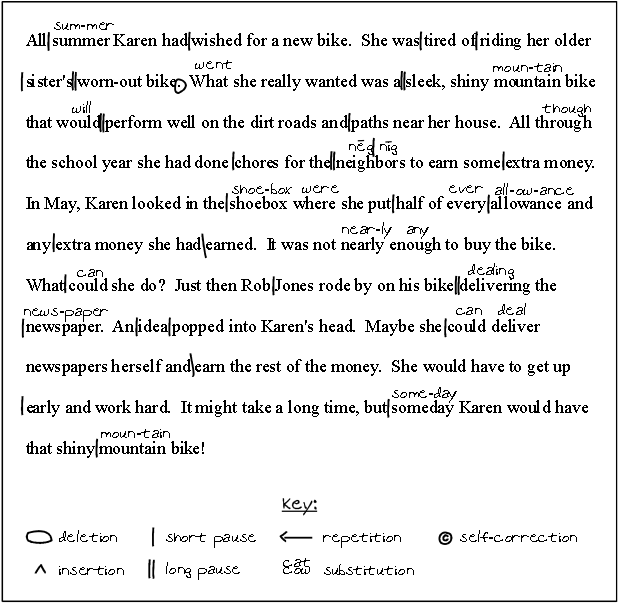Study Guide
Sample Open-Response Item Assignment
This section of the study guide contains:
- Sample test directions for the open-response item assignments
- A sample open-response item assignment
- An example of a strong response to the assignment
- The performance characteristics and scoring scale
Sample Test Directions for Open-Response Item Assignments
This section of the test consists of two open-response item assignments. You will be asked to prepare a written response of approximately 150–300 words for each assignment. You should use your time to plan, write, review, and edit your response for each assignment. You must write responses to both of the assignments.
For each assignment, read the topic and directions carefully before you begin to work. Think about how you will organize your response.
As a whole, your response to each assignment must demonstrate an understanding of the knowledge of the field. In your response to each assignment, you are expected to demonstrate the depth of your understanding of the subject area by applying your knowledge rather than by merely reciting factual information.
Your response to each assignment will be evaluated based on the following criteria.
- PURPOSE: the extent to which the response achieves the purpose of the assignment
- SUBJECT KNOWLEDGE: appropriateness and accuracy in the application of subject knowledge
- SUPPORT: quality and relevance of supporting evidence
- RATIONALE: soundness of argument and degree of understanding of the subject area
The open-response item assignments are intended to assess subject knowledge. Your responses must be communicated clearly enough to permit valid judgment of the evaluation criteria by scorers. Your responses should be written for an audience of educators in this field. The final version of each response should conform to the conventions of edited American English. Your responses should be your original work, written in your own words, and not copied or paraphrased from some other work.
Be sure to write about the assigned topics. You may not use any reference materials during the test. Remember to review your work and make any changes you think will improve your responses.
Sample Open-Response Item Assignment
Use the information below to complete the exercise that follows.
Jonathan, a third-grade student, reads aloud a passage from an unfamiliar story. As he reads, the teacher notes his performance on a separate copy of the story. Printed below is an excerpt from the teacher's record of Jonathan's oral reading performance.

Using your knowledge of word identification strategies (e.g., use of phonics, analysis of word structure, use of context clues, identification of sight words), write a response in which you:
- identify one of Jonathan's strengths in using word identification strategies; and
- identify one of Jonathan's weaknesses in using word identification strategies.
Be sure to cite specific evidence from the information shown to support your response.
Sample Strong Response to the Sample Open-Response Item
The sample response below reflects a strong knowledge and understanding of the subject matter.
This record of Jonathan's oral reading suggests that one of his word identification strengths is the ability to apply knowledge of word structure. The teacher's notes suggest that Jonathan divides multisyllable words into smaller units to identify them. In some cases the smaller units are syllables (e.g., sum-mer, moun-tain, all-ow-ance). First he uses knowledge of phonics to sound out individual syllables. He is then able to identify the word as a whole. In other cases the smaller units are the two words that make up a compound word. The teacher's notes suggest that Jonathan looks for and recognizes the constituent words that form the compound words shoe-box, news-paper, and some-day.
The teacher's notes also suggest that Jonathan has some weaknesses in word identification. One weakness relates to identification of high-frequency words with irregular spellings. Such words are usually referred to as "sight words." Readers need to learn to recognize these words automatically (i.e., memorize them) because the words cannot be identified by applying common phonics generalizations or by analyzing the word's structure. The passage that Jonathan reads aloud includes a number of these words: what, would, through, where, enough, could. Notice the miscues he makes (without self-correcting) for each of these words: went for what, will for would, though for through, were for where, any for enough, can for could. The word neighbor is also a sight word, and he makes two unsuccessful efforts to decode it by using phonics.
Performance Characteristics
The following characteristics guide the scoring of responses to the open-response item(s).
| Purpose | The extent to which the response achieves the purpose of the assignment. |
|---|---|
| Subject Matter Knowledge | Accuracy and appropriateness in the application of subject matter knowledge. |
| Support | Quality and relevance of supporting details. |
| Rationale | Soundness of argument and degree of understanding of the subject matter. |
Scoring Scale
The scoring scale below, which is related to the performance characteristics for the tests, is used by scorers in assigning scores to responses to the open-response items.
| Score Point | Score Point Description |
|---|---|
| 4 |
The "4" response reflects a thorough knowledge and understanding of the subject matter.
|
| 3 | The "3" response reflects an adequate knowledge and understanding of the subject matter.
|
| 2 | The "2" response reflects a limited knowledge and understanding of the subject matter.
|
| 1 | The "1" response reflects a weak knowledge and understanding of the subject matter.
|
| U | The response is unrelated to the assigned topic, illegible, primarily in a language other than English, not of sufficient length to score, or merely a repetition of the assignment. |
| B | There is no response to the assignment. |